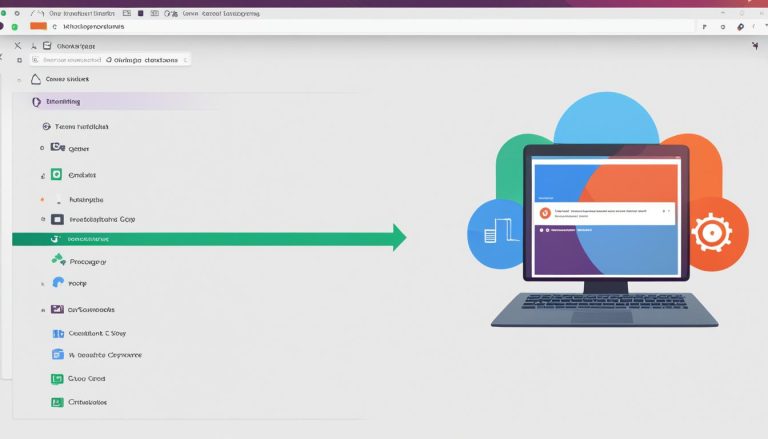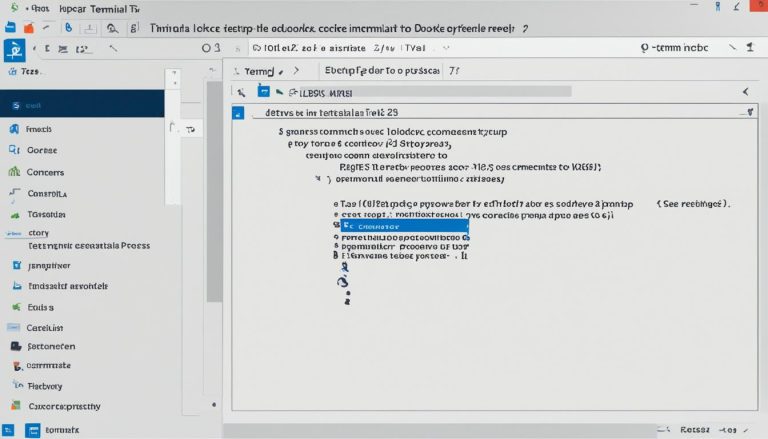Mastering Raspberry Pi: Schedule Reboot with Ease
If you’re looking to schedule a reboot on your Raspberry Pi, you’ve come to the right place. In this guide, I’ll teach you how to automate the reboot process on your Raspberry Pi, allowing you to enhance its performance and improve its uptime. With over 8 million Raspberry Pi units sold, it’s clear that this versatile device is not just a plaything but has a wide range of applications. Whether you’re using your Raspberry Pi for educational purposes or more advanced projects, learning how to schedule a reboot can be a valuable skill.
Key Takeaways:
- Scheduling reboots on your Raspberry Pi can improve performance and uptime.
- Automating the reboot process allows for a more optimized computing experience.
- There are multiple methods to schedule reboots, such as using cron, applications, editing rc.local, or creating a new file in /etc/init.d.
- Experiment with different methods to find the one that best fits your needs and preferences.
- Regularly scheduled reboots can enhance the overall reliability of your Raspberry Pi.
Why Schedule a Reboot on Your Raspberry Pi?
There are several reasons why you might want to schedule a reboot on your Raspberry Pi. First, regular reboots can help improve the device’s overall performance by clearing out any temporary files or processes that may be causing slowdowns. Additionally, scheduling a reboot can help ensure that any updates or changes to your Raspberry Pi’s software are implemented smoothly.
By automating the reboot process, you can save time and effort, allowing your Raspberry Pi to run more efficiently and reliably. Whether you’re using your Raspberry Pi for educational purposes or more advanced projects, learning how to schedule a reboot can be a valuable skill. With the ability to enhance performance and improve uptime, scheduling reboots on your Raspberry Pi is a practical step towards optimizing the device’s capabilities.
Automating the reboot process on your Raspberry Pi can also help with troubleshooting. If you’re experiencing any issues with your device, a reboot can often resolve minor glitches or conflicts. By scheduling regular reboots, you can proactively prevent and resolve potential problems, ensuring that your Raspberry Pi runs smoothly and consistently.
Regular reboots can help improve performance, ensure smooth software updates, save time and effort, and assist with troubleshooting. By scheduling reboots on your Raspberry Pi, you can optimize its performance and enhance its overall reliability.
Why Schedule a Reboot on Your Raspberry Pi?
- Improves device performance by clearing temporary files and processes.
- Ensures smooth implementation of software updates and changes.
- Saves time and effort by automating the reboot process.
- Aids in troubleshooting by resolving minor glitches and conflicts.
Methods for Scheduling a Reboot on Raspberry Pi
If you’re looking to schedule a reboot on your Raspberry Pi, there are multiple methods you can choose from. These methods provide flexibility and options depending on your specific needs and preferences. Let’s explore some of the popular ways to schedule a reboot on your Raspberry Pi:
Using the shutdown command
Probably the easiest way to reboot a Raspberry PI or any other computer running linux is using the “shutdown” command. Apart from the “-r” switch which tells shutdown to do a reboot you can add a date or time to the shutdown command.
As an examplte: The command “shutdown -r 02:45” will reboot your Raspi at 02:45 am the next night.
Taken from the man-page of shutdown: “The time string may either be in the format “hh:mm” for hour/minutes specifying the time to execute the shutdown at, specified in 24h clock format. Alternatively it may be in the syntax “+m” referring to the specified number of minutes m from now. “now” is an alias for “+0”, i.e. for triggering an immediate shutdown. If no time argument is specified, “+1” is implied.
Using the Crontab
One of the easiest and commonly used methods is using the crontab. By adding a new line to the crontab file with the “@reboot” keyword followed by the command to execute, you can ensure that your desired script or command runs automatically on boot. This method is simple and effective, allowing you to automate the reboot process with ease.
Using an Application like Startup Applications Preferences
If you’re using a distribution with a desktop environment like Ubuntu, you can use an application like Startup Applications Preferences to schedule a reboot on your Raspberry Pi. This user-friendly tool allows you to easily add scripts or applications to the list of programs that start automatically on boot. It’s a great option for those who prefer a graphical interface and want a hassle-free way to schedule reboots.
Editing the rc.local File or Creating a New File in /etc/init.d
For more advanced users or those who prefer a script-based approach, you can edit the rc.local file or create a new file in the /etc/init.d directory to start a script on boot. These methods provide more customization options and allow you to create more complex scripts and functionalities. They are ideal for those who require more control over the reboot scheduling process.
Choose the method that best suits your needs and preferences to schedule reboots on your Raspberry Pi. Whether you opt for the simplicity of the crontab, the user-friendly application, or the advanced customization of editing files, automating the reboot process will enhance the performance and reliability of your Raspberry Pi.
Using Crontab to Schedule Reboot on Raspberry Pi
To schedule a reboot using the crontab on your Raspberry Pi, you can easily edit the crontab file and add a new line with the “@reboot” keyword followed by the command you want to execute. This method provides a simple and effective way to automate the reboot process on your device.
Here is an example of how the crontab entry should look:
@reboot /usr/bin/sudo /sbin/reboot
Make sure to include the full path to your script or command to ensure it runs correctly. You can also use the crontab to schedule regular reboots at specific times or intervals by using other keywords like “@daily” or “@weekly”. This flexibility allows you to customize the reboot schedule to fit your needs.
Using Crontab to Schedule Reboot on Raspberry Pi
To schedule a reboot using the crontab on your Raspberry Pi, follow these steps:
- Open the terminal on your Raspberry Pi.
- Type
1crontab -e
to open the crontab file for editing.
- Add a new line with the “@reboot” keyword followed by the command you want to execute. For example:
1@reboot /usr/bin/sudo /sbin/reboot
- Save the file and exit the editor.
- Your Raspberry Pi will now automatically reboot on startup according to the schedule you set.
Using the crontab to schedule a reboot is a convenient and reliable method for automating the reboot process on your Raspberry Pi. It allows you to ensure that your device runs smoothly and stays up to date with any changes or updates.
| Command | Description |
|---|---|
| @reboot | Runs the specified command on system startup |
Using an Application to Schedule Reboot on Raspberry Pi
If you’re using a distribution with a desktop environment like Ubuntu, you can easily schedule a reboot on your Raspberry Pi by using an application called Startup Applications Preferences. This user-friendly tool allows you to add scripts or applications to the list of programs that start automatically on boot, including a reboot command. By utilizing this method, you can automate the reboot process without requiring any manual editing of configuration files.
To schedule a reboot using Startup Applications Preferences, simply open the tool and click on the “Add” button. Fill in the details of your script or command, including the reboot command itself. Once you’ve added the necessary information, click “Save” to apply the changes. Now, your Raspberry Pi will automatically reboot at the scheduled time, ensuring smooth and efficient operation.
Using an application like Startup Applications Preferences provides a hassle-free way to schedule reboots on your Raspberry Pi. It eliminates the need for manual configuration and allows you to focus on your projects, knowing that your device will automatically reboot when needed.
Whether you’re a beginner or an advanced user, the ease of using an application like Startup Applications Preferences makes it an ideal choice for automating the reboot process on your Raspberry Pi. With just a few simple steps, you can ensure that your device stays up to date, optimized, and running smoothly without any manual intervention.
| Method | Advantages | Disadvantages |
|---|---|---|
| Using an Application (Startup Applications Preferences) | – User-friendly interface – No manual editing of configuration files required |
– Limited to distributions with a desktop environment |
| Using Crontab | – Flexible scheduling options – Works on all distributions |
– Requires manual editing of the crontab file |
| Editing rc.local | – Simple and straightforward method – No additional tools or modifications required |
– Limited customization options |
| Creating a New File in /etc/init.d | – More advanced customization options – Ideal for advanced users or specific requirements |
– Requires knowledge of scripting and system initialization |
Using an Application to Schedule Reboot on Raspberry Pi
If you’re using a distribution with a desktop environment like Ubuntu, you can use an application called Startup Applications Preferences to easily schedule reboots on your Raspberry Pi. This tool provides a user-friendly interface that allows you to add scripts or applications to the list of programs that start automatically on boot, including a reboot command. You can simply open the tool, click on the “Add” button, fill in the details of your script or command, and save it. This method eliminates the need for manual configuration and offers a hassle-free way to schedule reboots.
Editing rc.local for Reboot Scheduling on Raspberry Pi
One of the methods you can use to schedule a reboot on your Raspberry Pi is by editing the rc.local file. This file is executed on boot and allows you to start a script or command. By adding your desired script or command before the “exit 0” line in the rc.local file, you can ensure that it runs automatically on boot. It’s important to save the file and make it executable for the changes to take effect.
This method provides a straightforward approach to scheduling reboots and doesn’t require any additional tools or modifications. It’s a convenient option for those who prefer a script-based approach and want a reliable way to schedule reboots on their Raspberry Pi.
Step-by-Step Guide:
-
- Open the rc.local file with a text editor. You can use the following command to open it:
sudo nano /etc/rc.local
-
- Add your desired script or command before the “exit 0” line in the file.
- Save the file by pressing Ctrl + X, then Y, and finally Enter.
- Make the rc.local file executable by running the following command:
sudo chmod +x /etc/rc.local
Once you’ve completed these steps, your Raspberry Pi will execute the specified script or command on every boot. This allows you to schedule reboots and automate certain tasks or processes easily.
| Advantages | Disadvantages |
|---|---|
| Straightforward method | No graphical interface |
| No additional tools or modifications required | Requires manual editing of configuration files |
| Reliable way to schedule reboots | May not be suitable for users who prefer a graphical interface |
By editing the rc.local file, you can easily schedule reboots on your Raspberry Pi and automate specific tasks or processes. It provides a convenient and reliable method for those who prefer a script-based approach and want more control over the reboot scheduling process. Experiment with this method and discover how it can enhance the performance and efficiency of your Raspberry Pi.
Creating a New File in /etc/init.d for Reboot Scheduling on Raspberry Pi
Another method for scheduling a reboot on your Raspberry Pi is by creating a new file in the /etc/init.d directory. This method provides more customization options and is commonly used for starting services. To get started, follow these steps:
- Create a new file with the desired name in the /etc/init.d directory.
- Add the necessary header and script content to the file. This will include defining the command or script you want to run on reboot.
- Make the file executable by running the command “chmod +x /etc/init.d/your_file_name”.
- Enable the file to start on boot by running the command “sudo update-rc.d your_file_name defaults”.
This method allows you to create more complex scripts and functionalities, making it ideal for advanced users or those who require more control over the reboot scheduling process. With a customized file in the /etc/init.d directory, you can ensure that your Raspberry Pi reboots according to your specific requirements.
Here’s an example table showcasing the steps involved in creating a new file in the /etc/init.d directory:
| Step | Description |
|---|---|
| 1 | Create a new file |
| 2 | Add the necessary header and script content |
| 3 | Make the file executable |
| 4 | Enable the file to start on boot |
By following these steps and utilizing the /etc/init.d directory, you can schedule reboots on your Raspberry Pi efficiently and with greater customization.
Conclusion
Scheduling a reboot on your Raspberry Pi is a valuable skill that can greatly enhance its performance, uptime, and overall reliability. By automating the reboot process, you can ensure that your Raspberry Pi operates smoothly and efficiently.
There are multiple methods available for scheduling a reboot on your Raspberry Pi, each providing flexibility and options depending on your specific needs and preferences. Whether you choose to use the crontab, an application like Startup Applications Preferences, edit the rc.local file, or create a new file in the /etc/init.d directory, you have the power to customize your reboot scheduling process.
Regular reboots can help clear out temporary files and processes that may be causing slowdowns, implement updates or changes to your Raspberry Pi’s software smoothly, and save you time and effort. Experiment with different methods to find the one that best suits your requirements.
With your Raspberry Pi scheduled to reboot regularly, you can focus on your projects and enjoy a more optimized computing experience. So go ahead and schedule those reboots, and unlock the full potential of your Raspberry Pi.
FAQ
Why should I schedule a reboot on my Raspberry Pi?
Scheduling a reboot can help improve your Raspberry Pi’s performance, clear out temporary files, and ensure smooth implementation of software updates or changes.
What are the methods for scheduling a reboot on Raspberry Pi?
The methods include using crontab, using an application like Startup Applications Preferences, editing the rc.local file, or creating a new file in the /etc/init.d directory.
How do I use the crontab to schedule a reboot on Raspberry Pi?
To use the crontab, you need to edit the crontab file and add a new line with the “@reboot” keyword followed by the command you want to execute.
How do I use an application to schedule a reboot on Raspberry Pi?
If you’re using a distribution with a desktop environment like Ubuntu, you can use an application like Startup Applications Preferences to schedule a reboot. Simply add your script or command to the list of programs that start automatically on boot.
How do I edit the rc.local file to schedule a reboot on Raspberry Pi?
Open the rc.local file with a text editor, add your script or command before the “exit 0” line, save the file, and make it executable.
How do I create a new file in the /etc/init.d directory for reboot scheduling on Raspberry Pi?
Create a new file with the desired name, add the necessary header and script content, make it executable, and use the “sudo update-rc.d” command to enable it to start on boot.
Source Links
- https://forums.raspberrypi.com/viewtopic.php?t=142815&start=25
- https://raspberrytips.com/run-script-at-startup-on-linux/
- https://pyimagesearch.com/2016/05/16/running-a-python-opencv-script-on-reboot/
- About the Author
- Latest Posts
Mark is a senior content editor at Text-Center.com and has more than 20 years of experience with linux and windows operating systems. He also writes for Biteno.com






